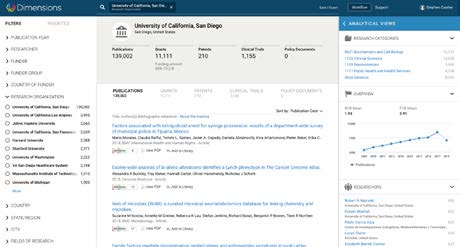“You could see that significant work had been done behind the scenes to make the data in Dimensions both usable and understandable.”
David Minor, Director, Research Data Curation Program, University of California, San Diego, United States
About the organization
For several years, the Library at University of California, San Diego, has been interested in helping stakeholders across campus answer analytical research questions. To this end, David Minor, Director, Research Data Curation Program, told us the Library took out a subscription to Dimensions.
Before they invested in Dimensions, the Library was trying to understand UC San Diego’s research activity but was getting hampered by inconsistent metadata based on extractions from over 150 different institutional repositories and various publisher sources. David comments “Dimensions offered something better. The rigor and consistency in the data structure was very obvious. It was easy to write a simple or complex query and when the data results were returned, you could trust them. You could see that significant work had been done behind the scenes to make the data in Dimensions both usable and understandable.”
Benefits of Dimensions
- Answer 3 critical questions: Where is research funding going? What is the connection between funding and publications? Who are the institution’s competitors in specific research domains or disciplines?
- Immediacy of the data helps users to see what has happened in a specific research field in the previous 12 months
- Interesting features are connected into the landing pages in the tool. These include ORCID, and the altmetric attention scores.
Specific use cases
The analytical users for Dimensions come from the Office of Research Affairs, the Office of Research in the School of Medicine, the Campus IT organisation and the Office for Academic Affairs.
At the Office of Research Affairs and the the Office of Research in the School of Medicine, Dimensions is used to answer the following questions:
- Where is research funding going?
- What is the connection between funding and publications?
- Who are the institution’s competitors in specific research domains or disciplines?
In the Office for Research, David says you have different users with very different needs – those who manage grants and need data, then there are the people who help faculty find collaborators and need data, and those who work for the Chancellor to define campus strategy and goals, and need data. David goes on to say: “Half of our campus are posing these questions from a biomedical perspective. Our Cancer Center is very interested in Dimensions as they have designed a research organisation with staff to address a very specific set of research questions and they are bounded to very specific goals. Dimensions by its design seems to match their needs particularly well.”
David finds 2 aspects of Dimensions particularly appealing:
- The immediacy of the data helps users to see what has happened in a specific research field in the previous 12 months
- Interesting features are connected into the landing pages in the tool. These include ORCID, and the altmetric attention scores.
Investing in the API
David also wants to exploit the full capabilities of the Dimensions. To do this, he has added two data scientists to help in the Library. “We have hired 2 undergraduate data science students and from the Fall, they are going to be trained with the API documentation and will become expert at answering questions in Dimensions. They are also learning Tableau, R, and Python so they will be able to export and process data from Dimensions based on specific business queries from our campus stakeholders.”
“They will be able to export and process data from Dimensions based on specific business queries from our campus stakeholders.”

Would you like to learn about how Dimensions can support research within your organization? Get in touch and one of our experts would be happy to speak to you.
